Lessons for Australia on board the world’s fastest train
At 500 kilometres an hour, the Maglev could revolutionise rail travel. But it’s also causing plenty of controversy.
By Lisa Visentin and Eryk Bagshaw
Yamanashi, Japan: Inside the cabin of the world’s fastest train, the force of the propulsion pushes you back in your seat.
The wheels lift off as it races towards a speed of 500 kilometres an hour, levitating 10 centimetres above the track, around the foothills of Mount Fuji.
This is Japan’s ultrafast driverless Maglev train. The 129-metre-long bullet is barrelling at top speed around a 42.8-kilometre test track.
The levitation is the Maglev’s superconducting magnet technology at work. It has been long hailed as the future of high-speed rail.
The powerful magnets propel the train forward and upward, enabling it to glide above the track to reach speeds not safely achievable using regular wheels and rails. At this pace, friction would quickly wear out the technology that has defined train travel for two centuries.
It takes 2½ minutes for the train to accelerate to 500km/h, a pace that Central Japan Railway Company (JR Central) says will allow its passengers to travel from Tokyo to Nagoya in 40 minutes, and then to Osaka in 67 minutes once the train is fully operational. That journey now takes almost 2½ hours by regular high-speed rail.
The train is actually running well below its top speed, a world-record 603km/h set on this test track in 2015. The innovation of the Japanese Maglev is that travelling at this speed doesn’t feel remarkable at all. The ride is smooth and relatively quiet, and it is not buffeted by the typical bounce of wheels grinding against rail tracks or the screeching that often accompanies it.
Were it not for a speedometer screen at the front of the cabin, it would be difficult for the average passenger to gauge they were hurtling much faster than the 320km/h limit of Japan’s fastest Shinkansen bullet trains.
One clue appears through the double-paned cabin windows, when the pristine mountainous countryside is reduced to a blur as the train sprints between tunnels.
Arguably the best way to appreciate the speed is not by riding the train itself, but from a viewing platform as it barrels past. You have only a split second to clock the lights of the train’s approach, before feeling the whoosh of it roaring past you.
This journey of 438 kilometres, linking Japan’s two biggest cities, Tokyo and Osaka, is being billed as the Linear Chuo Shinkansen line, the most ambitious project yet in Japan’s famous high-speed Shinkansen rail network. However, the project hasn’t been without controversy.
After almost three decades of testing, only the test track section of the line has been completed. Most construction work for other sections remains in its early stages if it has commenced at all. The first stage from Tokyo to Nagoya was once expected to take 13 years to build. More than 80 per cent of the line runs underground, requiring costly excavation works.
JR Central is funding the project using low-interest loans from the Japanese government.
But it has run into hurdles that have blown out its timeline and its budget. In 2009, the entire project was estimated to cost 9 trillion yen. Now, just stage one alone is expected to cost 7 trillion yen ($70 billion), and it will not open until 2034 at the earliest.
As for the extension to Osaka, no revised estimates have been made public, and there is no timeline for its completion.
For years, one regional government district, the Shizuoka prefecture, single-handedly stalled the project’s stage one progress, refusing to greenlight the construction of an 8.9-kilometre tunnel through the region’s Southern Alps, citing environmental concerns.
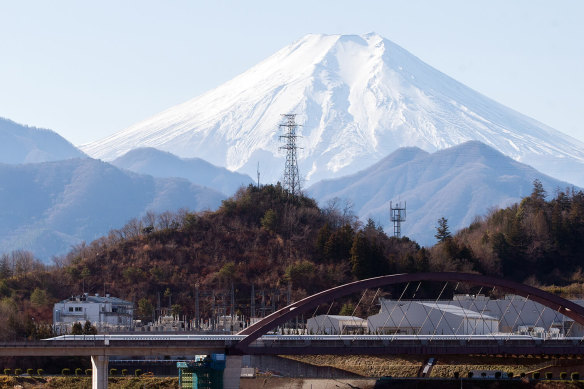
The Maglev travels past Mount Fuji. Credit:
Home to Mount Fuji, the Shizuoka prefecture is a verdant, picturesque region between Tokyo and Nagoya on the Pacific coast that seduces countless tourists with its towering mountains, famed hiking trails and pristine beaches. It is also the only prefecture along the proposed route that will not feature a stop for the Maglev.
Its long-serving governor, Heita Kawakatsu, was a thorn in the side of the project until his abrupt resignation in May. He refused to approve tunnelling works after it emerged the construction could reduce water flows in the Oi River system by two tonnes a second. He said this would affect farming and tap water supply to 600,000 residents for whom the river was a “lifeblood”.
A plan to pump the lost water back into the river failed to secure Kawakatsu’s approval.
The project was stuck at an impasse until April, when Kawakatsu was embroiled in controversy over a gaffe insulting farmers. He resigned, but not before claiming victory over JR Central’s concession days earlier that the 2027 opening date had been abandoned, declaring he had “achieved a major objective of my duty”.
With the election of a new governor, there are signs of the project gaining momentum again.
The Shizuoka prefecture last month granted JR Central approval to conduct a boring survey, a necessary pre-construction step. But the train company remains hesitant to commit to a new opening date, signalling that the difficult terrain means it will take at least a decade to build.
“The Shizuoka section is one of the most difficult tunnel construction projects, full of uncertainty,” Yoh Shigeta, deputy chief of Chuo-Shinkansen Promotional Headquarters, told journalists in a briefing last month.
“Due to the length of the mountains that needs to be dug, the completion schedule is uncertain as well. Therefore, Shizuoka Prefecture holds the key to realising the completion of this new train line.”
Torkel Patterson, a senior adviser and former director of JR Central, is certain the completed line to Osaka “will absolutely be built”.
“It’s the largest private sector project ever undertaken by one company,” he said in an interview.
“It may take another election cycle or two, but it’ll be done.”
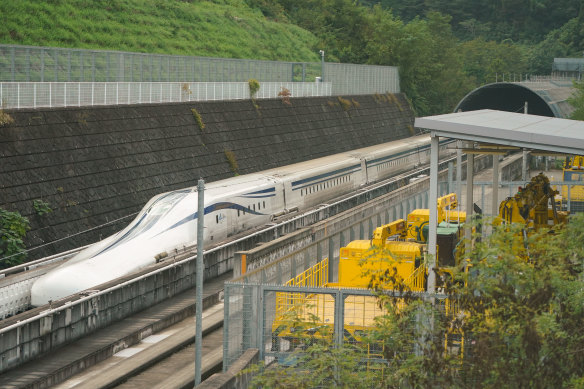
A general view of the Maglev train at Yamanashi Prefectural Maglev Exhibition Centre.Credit: Christopher Jue
The sheer size and scale of the project also pose serious questions about the viability of a similar ambition in Australia. Both sides of politics have toyed with the idea of constructing a high-speed rail line linking major east coast cities since the 1980s, but they have never gone much beyond feasibility and scoping studies.
The Albanese government has revived this ambition, creating a new national High-Speed Rail Authority in 2022. It committed $500 million to plan for and protect a corridor for a line between Sydney and Newcastle, as the first stage of a high-speed rail network. The business case, which cost $79 million alone, is due to be handed to the federal government by the end of this year.
JR Central is lobbying the government to be allowed to participate in the project. Prime Minister Anthony Albanese, a lifelong fast train enthusiast, met with the company as minister for transport in the early 2010s. More recently, he raised the subject with then Japanese prime minister Fumio Kishida when they met in Tokyo in 2022.
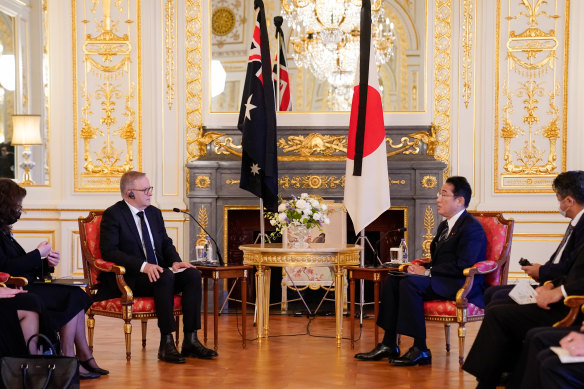
Australian Prime Minister Anthony Albanese meets with then Japanese prime minister Fumio Kishida in Tokyo in 2022. Credit: Christopher Jue
Tokyo says it is ready to pounce.
“After the report is out, our relevant minister is going to see the contents and intentions of the government of Australia,” says Maki Kobayashi, director general for press and public diplomacy at Japan’s Ministry of Foreign Affairs.
“Then they will try to co-ordinate with relevant ministries and think about how and whether we can work together.”
But economists are sceptical.
“Australia’s regional towns have more pressing infrastructure needs than faster rail, including better internet and mobile connectivity and freight links,” the Grattan Institute think tank said in 2020, estimating that an east coast high-speed rail network would cost taxpayers $10,000 each over the life of the project.
“Even at the best of times, it’s a big ask for every taxpayer in the land to stump up $10,000 primarily for the benefit of business travellers between the east coast capitals.”
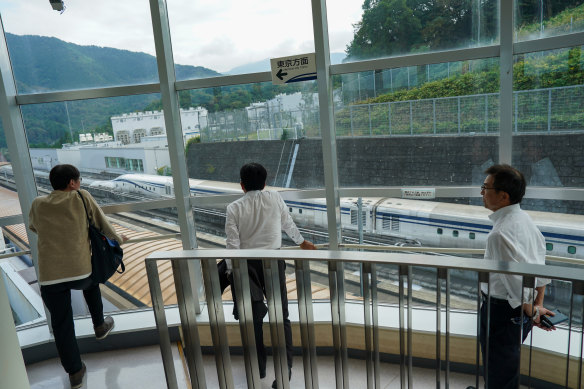
The Maglev goes past the Yamanashi Prefectural Maglev Exhibition Centre in October. Credit: Christopher Jue
JR says it won’t be pitching a Maglev for Australia. The technology is far more expensive than conventional high-speed trains and requires a huge amount of energy to run.
Patterson says it’s not appropriate for Australia without the population to justify it.
“There’s really only one other place [outside Tokyo-Osaka] that has the people and the ridership to do it. That’s Washington DC to Boston [via New York],” he says.
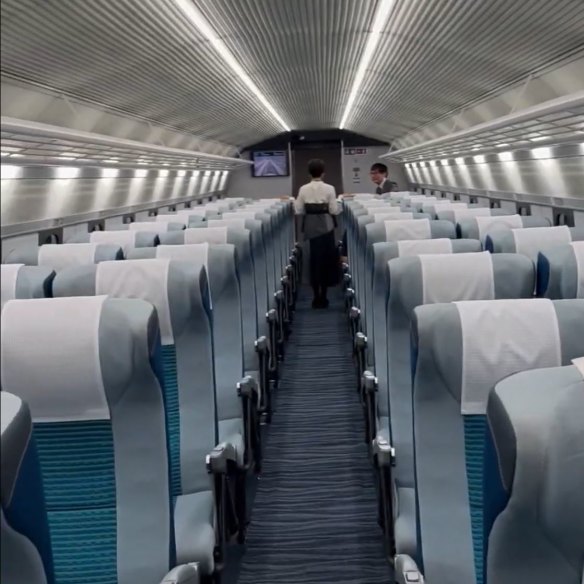
The interior of a Maglev cabin during a test run in Japan.Credit: Screenshot/Lisa Visentin
Patterson says Taiwan’s JR-built high-speed rail between Taipei and Kaohsiung is the model that could be most easily replicated in Australian conditions.
“Australia has just the right size, and it’s in the sweet spot for the two city pairs, Melbourne and Sydney,” he said.
“High-speed rail investment is not just about investing in another transportation source. It’s investing in the transformation of the society.”
High-speed rail proponents say the technology allows settlements to spread, increasing the standard of living by freeing up land for people to buy houses while cutting their commute times and increasing productivity.
“The underlying big picture question is: do we expect Australia to be a 20 million-something country or a 50 million-something country in 30 years? And when is it the cheapest to do it? The cheapest to do it is now,” says Patterson. “But you have to make the first step.”
Patterson says cutting corners or attempting to build on existing infrastructure would cause the project to fail, citing the example of California’s high-speed rail line, which will have fast trains mix with regular trains as they enter Los Angeles.
“California will never recover from doing that. They have to slow to 40 miles [64 kilometres] per hour to go through the city. And that means that every train behind that backs up.”
The defining factor behind the efficiency and punctuality of Japan’s network is that it is made up of single dedicated tracks without any level crossings. That means tunnelling through mountains and building above streets.
“It’s really important to give thought when you build this to building as straight as possible and [as a] dedicated line. Don’t use any existing infrastructure,” says Patterson.
“People say, ‘Oh, it’s going to be so expensive’, but don’t be tempted by that. It doesn’t have to be a Japanese train. Put a European train, put any train you want. Just go straight.”
The Japanese and US examples show high-speed rail projects are a massive commitment in terms of cost, time and disruption, which may prove an insurmountable challenge in a political system like Australia’s.
Three-year federal election cycles have increasingly rewarded low-risk short-term political agendas aimed primarily at securing and maintaining power. This has reduced political appetites for taking on ambitious, costly projects that are likely to run into hurdles, and for which a future government, possibly from the rival side of politics, will take the credit when it is time to cut the ribbon.
And that’s before considering how unpopular such large-scale costly projects can quickly become during fraught economic times when voters are grappling with acute cost-of-living concerns.
International High-Speed Rail Association vice chairman Joseph Schmelzeis says Japan’s transformation to the world’s largest high-speed rail network “wasn’t quick either”.
The first Shinkansen was proposed in the 1930s, but it was not until 1964 that any of the now ubiquitous bullet trains began running.
“We take it for granted now. It was not easy at all. It took a really long time,” says Schmelzeis.
Today, 60 per cent of the Japanese economy runs along the Tokaido Shinkansen line between Osaka and Tokyo. Similarly, the Beijing-Shanghai high-speed railway helps fuel China’s economic engine, particularly as it links major cities in the Yangtze River Delta, including Suzhou, Zhenjiang, and Nanjing.
“What is globally competitive is not countries,” says Patterson. “It’s mega-regions.”
Get a note directly from our foreign correspondents on what’s making headlines around the world. Sign up for the weekly What in the World newsletter here.